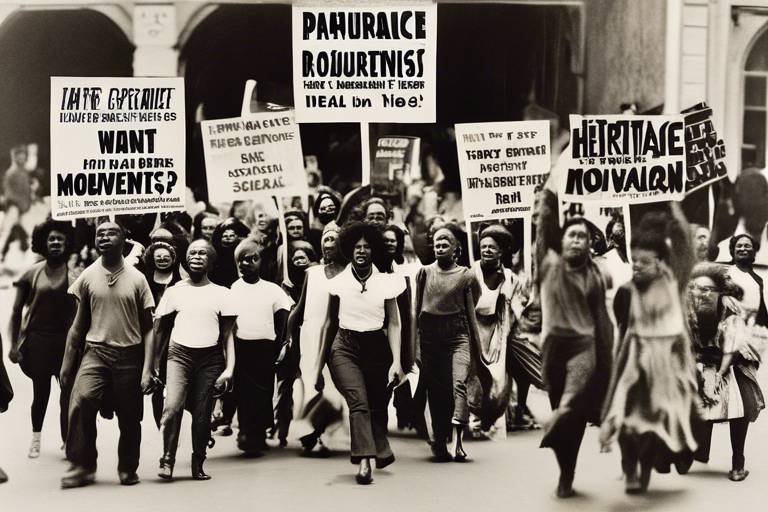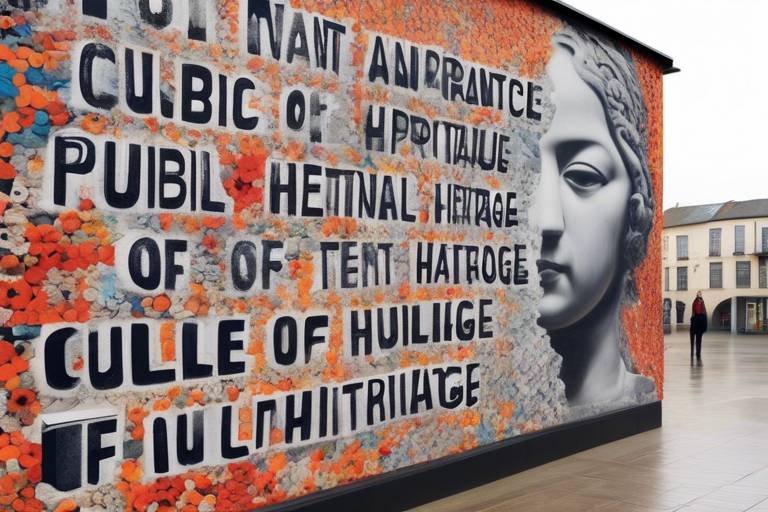The Legacy of the Cold War on Cultural Heritage
The Legacy of the Cold War on Cultural Heritage is a complex and multifaceted topic that delves into the profound impact of this historical period on the world's cultural treasures. The Cold War, characterized by intense political and ideological tensions between the East and the West, left a lasting imprint on cultural heritage sites and artifacts across the globe.
During the Cold War, the destruction of cultural heritage sites was a tragic consequence of conflicts and power struggles. Many iconic landmarks and historical sites fell victim to intentional bombings or neglect, leading to irreparable loss and damage. The ideological differences between the superpowers often resulted in the disregard for the value of cultural heritage, with devastating consequences for humanity's shared history.
Amidst the tensions of the Cold War, there were remarkable efforts made to preserve cultural heritage sites. Organizations and individuals recognized the importance of safeguarding these treasures from destruction, despite the political challenges they faced. These preservation efforts served as a beacon of hope amidst the turmoil of the era, emphasizing the significance of cultural heritage in uniting people beyond political divides.
Following the end of the Cold War, a period of rediscovery and restoration emerged for many cultural heritage sites. Places that were once inaccessible or forgotten were rediscovered, sparking renewed interest in their preservation and protection. The post-Cold War era brought about a renewed sense of responsibility towards cultural heritage, with initiatives aimed at restoring and conserving these valuable artifacts for future generations to appreciate.
The impact of the Cold War on art and architecture was profound, influencing the styles and themes of artistic creations during the era. Propaganda and ideological motifs often found their way into artistic expressions, reflecting the political climate of the time. This legacy continues to shape the cultural landscape, serving as a reminder of the interconnectedness between history, politics, and artistic expression.
Technological advancements during the Cold War revolutionized the preservation and documentation of cultural heritage. Innovations in conservation methods and digital technologies enabled more effective ways to safeguard and record these treasures, ensuring their longevity and accessibility for future generations.
In response to the threats faced by cultural heritage during the Cold War, international collaborations and agreements were established to protect and conserve these valuable artifacts and sites. The recognition of cultural heritage as a universal heritage transcending political boundaries led to collective efforts to safeguard these treasures from further harm.
Espionage and intelligence activities during the Cold War had far-reaching implications for cultural heritage. Reports of theft, smuggling, and covert operations targeting valuable artifacts raised concerns about the security and preservation of cultural treasures. The shadow of espionage continues to linger over cultural heritage, underscoring the need for vigilance and protection against illicit activities.
In the aftermath of the Cold War, educational initiatives and awareness campaigns have been launched to promote the importance of preserving cultural heritage. Lessons learned from the turbulent period of the Cold War serve as a reminder of the fragility of cultural treasures and the need for collective action to ensure their survival for future generations.

Destruction of Cultural Heritage Sites
During the Cold War, the destruction of cultural heritage sites was a tragic consequence of the conflicts and ideological tensions that permeated the era. Countless historical landmarks, monuments, and artifacts fell victim to intentional bombings, looting, and neglect, resulting in irreparable loss and damage to humanity's shared heritage. The indiscriminate nature of warfare often led to collateral damage, with iconic sites such as churches, museums, and ancient ruins becoming casualties of political strife and military operations.
One of the most devastating aspects of the destruction of cultural heritage sites during the Cold War was the loss of irreplaceable artifacts and historical records that held significant cultural and historical value. These sites served as tangible links to the past, providing insights into the diverse civilizations and societies that once thrived in different regions of the world. The deliberate targeting of cultural heritage sites as a strategy of war not only erased physical structures but also erased collective memories and identities associated with these places.
Despite efforts by some countries and organizations to safeguard cultural heritage sites, the pervasive climate of suspicion and conflict during the Cold War often hindered effective preservation initiatives. The prioritization of military objectives over cultural preservation led to the neglect and destruction of numerous sites that held immense cultural significance. The ideological divide between East and West further complicated efforts to protect and conserve these invaluable treasures, perpetuating the cycle of destruction and loss.
The destruction of cultural heritage sites during the Cold War serves as a stark reminder of the human cost of ideological conflicts and the fragility of our shared heritage. The scars left by this period continue to resonate in the present day, underscoring the importance of learning from the mistakes of the past and redoubling efforts to protect and preserve cultural heritage for future generations.

Preservation Efforts Amidst Tensions
The Cold War had a profound impact on cultural heritage worldwide. This article explores how this period influenced the preservation, destruction, and rediscovery of cultural artifacts and sites.
Amid the heightened tensions of the Cold War, a ray of hope shone through as dedicated individuals and organizations banded together to protect and preserve cultural heritage sites. Despite the looming threat of conflicts and ideological differences, these preservation efforts stood as beacons of resilience in the face of adversity.
Imagine a world where ancient temples, historic landmarks, and priceless artifacts faced the constant danger of destruction. In this tumultuous era, where political tensions ran high and the threat of war loomed large, the commitment to safeguarding cultural treasures became a mission of paramount importance.
Through collaborative initiatives and sheer determination, preservationists worked tirelessly to shield these invaluable pieces of history from the ravages of conflict. Their efforts transcended borders and ideologies, uniting individuals in a common goal of protecting the legacy of humanity from being lost to the turmoil of the times.
While the specter of destruction loomed ominously, the resilience of those dedicated to preservation shone brightly. Their unwavering commitment to cultural heritage stood as a testament to the enduring power of art, history, and the human spirit in the face of adversity.
As tensions ebbed and flowed on the global stage, the efforts of these unsung heroes remained steadfast, a beacon of hope amidst the chaos of the Cold War. Their legacy serves as a reminder of the importance of preserving our shared cultural heritage, even in the darkest of times.

Rediscovery and Restoration Post-Cold War
After the end of the Cold War, a wave of rediscovery and restoration swept across the globe, uncovering cultural heritage sites that had long been hidden or forgotten. This period marked a new chapter in the preservation and protection of these valuable artifacts, as efforts were made to restore and safeguard them for future generations to appreciate and learn from.
One significant aspect of the post-Cold War era was the emphasis on collaboration and international cooperation in the rediscovery and restoration of cultural heritage sites. Countries that were once divided by ideological differences now came together to work towards a common goal of preserving their shared history and heritage. This collective effort not only led to the rediscovery of lost treasures but also paved the way for innovative conservation techniques and practices.
Technological advancements played a crucial role in the post-Cold War rediscovery and restoration efforts. The use of advanced imaging techniques, such as 3D scanning and digital mapping, allowed archaeologists and conservationists to document and analyze cultural artifacts with unprecedented precision. These tools not only aided in the restoration process but also contributed to the development of new methods for preserving and protecting cultural heritage sites.
Furthermore, the post-Cold War period saw a renewed focus on public awareness and education regarding the importance of cultural preservation. Educational initiatives were launched to engage communities in the rediscovery and restoration process, fostering a sense of ownership and pride in their shared heritage. By involving the public in these efforts, a greater appreciation for cultural artifacts and sites was cultivated, ensuring their continued protection and conservation for future generations.

Impact on Art and Architecture
The impact of the Cold War on art and architecture was profound and far-reaching. During this tumultuous period, artistic and architectural styles were heavily influenced by the prevailing political ideologies and propaganda of the time. Artists and architects often incorporated themes of conflict, power struggles, and ideological tensions into their works, reflecting the intense atmosphere of the Cold War era.
One notable aspect of the impact on art and architecture was the prevalence of monumental and imposing structures that symbolized strength and authority. Buildings and sculptures often served as propaganda tools, projecting power and dominance in the face of perceived threats. The architectural landscape was shaped by the desire to make bold statements and showcase technological prowess, mirroring the arms race and competition between superpowers.
Furthermore, the Cold War era saw the rise of abstract and avant-garde artistic movements that challenged traditional norms and experimented with new forms of expression. Artists sought to convey complex emotions and ideas through unconventional means, pushing the boundaries of artistic conventions and exploring the depths of human experience in a world overshadowed by the specter of nuclear conflict.
Architectural innovations also emerged during this period, driven by the need for functional and efficient design in response to changing societal needs and security concerns. Bunker-like structures, underground facilities, and fortified buildings became common features of the architectural landscape, reflecting the pervasive sense of insecurity and the constant threat of war.
In conclusion, the impact of the Cold War on art and architecture was multifaceted, shaping the creative output of the time and leaving a lasting imprint on cultural expression. The legacy of this period continues to influence artistic and architectural practices today, serving as a reminder of the complex interplay between politics, society, and creativity in times of conflict and uncertainty.

Technological Advancements in Preservation
During the Cold War era, technological advancements played a crucial role in the preservation and documentation of cultural heritage. Innovations in imaging technology, such as photography and early forms of digital imaging, allowed for more detailed and accurate records of artifacts and sites. These advancements enabled archaeologists and preservationists to create comprehensive databases and archives, ensuring that valuable cultural treasures could be safeguarded for future generations.
One significant technological advancement that emerged during the Cold War was the development of satellite imagery. Satellites provided a bird's eye view of cultural heritage sites, allowing experts to monitor and assess potential threats to these locations. This aerial perspective revolutionized the way cultural heritage was studied and protected, offering new insights and opportunities for preservation efforts.
Furthermore, the use of Geographic Information Systems (GIS) became increasingly prevalent in the preservation of cultural heritage. GIS technology allowed researchers to overlay various data sets, including topographical maps, historical records, and archaeological findings, to create detailed visualizations of cultural sites. This integration of data facilitated more informed decision-making processes regarding conservation and management strategies.
Another notable advancement in preservation technology was the introduction of non-invasive techniques for artifact analysis. Methods such as ground-penetrating radar, 3D scanning, and X-ray fluorescence spectroscopy enabled researchers to study artifacts without causing damage, providing valuable insights into the composition and condition of cultural objects. These non-destructive techniques revolutionized the field of cultural heritage preservation, allowing for more thorough examinations and conservation practices.

International Collaborations for Protection
International collaborations played a crucial role in protecting cultural heritage during the Cold War. As conflicts and tensions threatened valuable artifacts and sites, countries came together to establish agreements and partnerships aimed at safeguarding these treasures. Through joint efforts and shared resources, the international community worked towards the preservation and conservation of cultural heritage, transcending political differences for the greater good.

Legacy of Espionage on Cultural Heritage
Espionage and intelligence activities during the Cold War era cast a shadow over cultural heritage, with clandestine operations impacting the preservation and security of valuable artifacts and sites. The cloak-and-dagger world of espionage often intersected with the realm of cultural treasures, leading to reports of theft, smuggling, and covert operations that endangered the integrity of historical artifacts.
Agents from rival nations engaged in espionage not only for political and military gain but also to gain control over significant cultural assets. The allure of ancient artifacts and valuable artworks made them targets for espionage activities, with reports of secret missions to acquire, manipulate, or even destroy cultural heritage items for strategic purposes.
The legacy of espionage on cultural heritage is a reminder of the complex interplay between politics, power, and the preservation of history. The clandestine nature of these activities often left a trail of uncertainty and mistrust, raising questions about the true extent of the damage caused by espionage during the Cold War.

Educational Initiatives for Cultural Preservation
Educational initiatives play a crucial role in the preservation of cultural heritage by raising awareness and promoting the significance of safeguarding these valuable artifacts and sites. These initiatives aim to educate the public, especially the younger generation, about the importance of cultural preservation and the impact of historical events like the Cold War on our shared heritage.
Through educational programs, workshops, and outreach activities, individuals are encouraged to actively participate in the conservation efforts and become stewards of cultural heritage. Schools, museums, and cultural institutions often collaborate to develop curriculum materials that highlight the value of preserving cultural artifacts and the stories they tell about our past.
Furthermore, digital technologies have been utilized to create virtual tours and interactive platforms that allow people from around the world to explore cultural heritage sites remotely. These initiatives not only make cultural heritage more accessible but also engage a wider audience in understanding and appreciating the importance of preservation.
By integrating cultural preservation into educational initiatives, future generations are equipped with the knowledge and skills needed to protect and conserve our shared heritage for years to come. Through learning about the challenges faced by cultural heritage during periods like the Cold War, individuals are inspired to take action and ensure that these treasures are safeguarded for future generations to enjoy.
Frequently Asked Questions (The title must be written in English)
- What cultural heritage sites were most affected during the Cold War?
During the Cold War, significant cultural heritage sites such as historic buildings, monuments, and archaeological sites in regions of conflict or ideological importance were particularly vulnerable to destruction or damage.
- How did the Cold War impact the preservation of cultural artifacts?
The Cold War presented challenges to the preservation of cultural artifacts due to the political tensions and conflicts that often led to intentional or inadvertent destruction. However, it also spurred efforts to protect and safeguard these treasures from further harm.
- What role did international collaborations play in protecting cultural heritage?
International collaborations played a crucial role in protecting cultural heritage during the Cold War, as countries and organizations came together to establish agreements and initiatives aimed at conserving valuable artifacts and sites from the threats posed by the geopolitical climate.
- How has the legacy of the Cold War influenced artistic and architectural styles?
The legacy of the Cold War is evident in artistic and architectural styles of the time, with propaganda and ideological influences shaping the creations of that era. This influence can still be seen in various cultural expressions today.



















